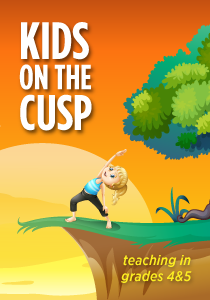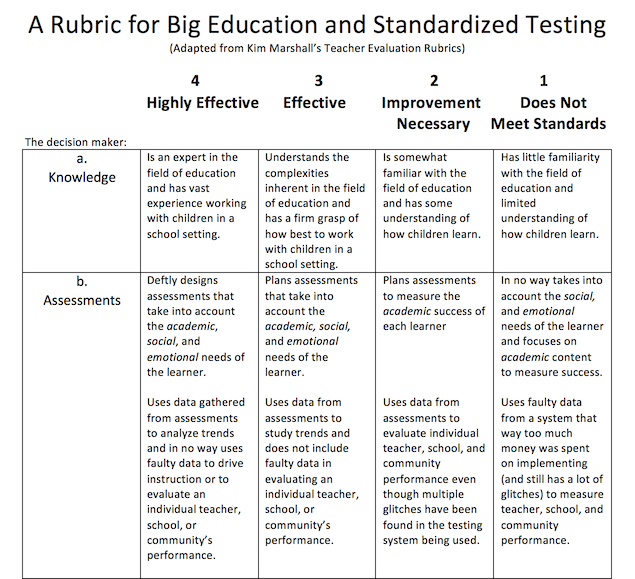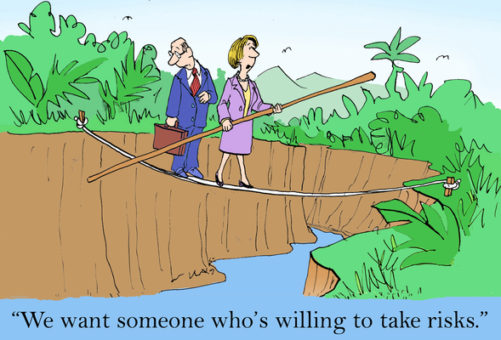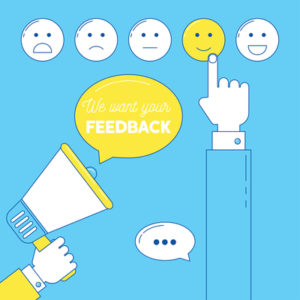A Rubric BIG Education Can Use to Assess Itself
A MiddleWeb Blog
 Last week I had to complete my second annual self-assessment. It’s now a mandatory component of my End-of-Year Evaluation here in New Jersey.
Last week I had to complete my second annual self-assessment. It’s now a mandatory component of my End-of-Year Evaluation here in New Jersey.
I firmly believe there are many, many things wrong with our current system of teacher evaluation, but I can’t say that sitting down to reflect on the year was necessarily a bad thing.
The importance of reflecting on our work is something we do all year in our classroom. It’s a critical life skill. I encourage the practice of self-reflection in my learners and in myself.
The rubric we are using in my district was created by a former principal and sixth grade teacher from Boston, Kim Marshall, who now works with New Leaders, a non-profit program dedicated in large part to training and supporting school principals. Marshall’s work focuses on how our school leaders can successfully evaluate teacher performance.
Marshall breaks teaching down into more concise areas: time management, curriculum unit design, differentiation, relationships, and respect. And other than what I consider an overuse of absolutes that make earning the “highest achievement” virtually impossible to achieve, I do appreciate his useful methodology…and all of his hard work.
The domains involved in being a teacher aren’t easy to define. I don’t know if a quantitative analysis of anything so vast and varied is even possible, and I think Kim Marshall knows this too.
I do appreciate how his efforts have given me time to pause, but it sure took an awful lot of pause to get through so many pages of self-reflection. It took him six pages of grids, each containing ten separate, yet related topics, to even begin to discuss what teachers do each day.
Rubric Inspired Reflections
Impossible though it may be to fully describe a teacher’s work, Marshall’s rubric did make me reflect closely on my own standards of good teaching.
His rubrics identify key elements of how we affect our learners, with categories like Knowledge, Engagement, Relationships, Differentiation, Respect, and Reflection. These are just a few of the many domains I visited while assessing my own development and growth.
Rubrics can be a useful guide. Their specificity enables me to peer through the lens and focus on the tiny details that make up “the whole teacher.” But finding the right rubric?…Well, that gets a bit more complicated.
Finding the Right Rubric
I generally pick-and-choose, cut-and-paste, or edit out bits and pieces of certain rubrics whose verbiage makes sense to me. I need guidelines to practice quality student assessment and individual goal-setting. Rubrics can help me establish benchmarks of individual achievement, and their creators put an effort into helping put into words something so impossible to accurately measure. Teacher Planet offers a wide variety of content-specific rubrics.
The kinds of rubrics I am naturally drawn to contain very few absolutes (if any). Certain words and phrases, like always and at all times have no place in the rubrics I consult…and I do roll my eyes when posed with the question of whether or not I am capable of holding each and every one of my student’s attention virtually all of the time during the course of an entire school day.
Educators like Melissa Purtee remind me about the pitfalls of using absolutes in measuring an individual, regardless of their chronological age. The experience of other educators helps my eyes stop rolling and regain clarity. Then my vision clears, and I remember that I am a “Highly Effective” teacher, whether or not a rubric is able to capture the whole picture.
Evaluating the Decision Makers
This got me thinking that it might be fun to develop a rubric that we, as educators, could use to evaluate the decision makers who are currently determining the rules that try to rate and define who we are.
Maybe they should have a rubric too. Maybe it’s time to ask the decision-makers to take a look at themselves a little more closely, to self-assess…to see if BIG Education is performing up to standards.
Let’s call it, “A Rubric for Big Education and Standardized Testing.” Here’s the beginning of a first draft to consider. Click it to enlarge.

NJ Ed Department Reaches Out for Feedback
A few days after spending time venting (please consult above rubric), I received an email from our Language Arts supervisor, Tiffany. Since joining our district, she has given me a great deal of valuable feedback and support, recognizing what I do well and offering suggestions about how I can grow as an educator.
Tiffany forwarded me an email that she’d received from Lamont Repollet, the Acting Commissioner for New Jersey’s Department of Education. The email asked “Chief School Administrators, Charter School and Renaissance School Project Leads” to inform their “superintendents, teachers, test administrators, parents/caregivers, students and other stakeholders” that BIG Education in New Jersey is looking for feedback on student assessment.
According to the email, our feedback “will play an integral role in NJDOE’s short- and long-term plans for, and improvements to, the statewide assessment program.” They seem particularly interested in the PARCC test.
Maybe there is hope in their asking for feedback. Maybe BIG Education in New Jersey wants to self-assess more accurately. Maybe they have sent emails like this before, but those got lost in the administrative shuffle. Who knows?…maybe I could share my new rubric with them.
I clicked on this link to sign up to be part of the conversation.
Some Resources for Fellow Skeptics
This Politico Playbook article discusses how Pearson Education makes money regardless of student achievement.
A $186 million dollar mistake in Washington explained in Education Week, the Washington Post and studentaid.ed.gov. GRANTS, it seems, are to help with scholarships, not to profit private industry….$186 million could’ve been better spent!




































